Marulanda J.M. (ed.) Electronic Properties of Carbon Nanotubes
Подождите немного. Документ загружается.


Mechanisms of Single-Walled Carbon Nanotube Nucleation,
Growth and Chirality-Control: Insights from QM/MD Simulations
525
2. QM/MD method: Theoretical background
In this section we will present a brief account of the main theoretical methods and
algorithms employed in the QM/MD simulations that are presented in §3-5. Our approach
is based on the DFTB method. In essence this method is a two-centre approximation to the
popular DFT method, which has its origins in the 1990s (Porezag et al., 1995; Seifert et al.,
1996). Consequently, for systems consisting of hundreds of atoms (such as those considered
here), DFTB is ca. three orders of magnitude faster than traditional DFT methods. In DFTB
theory, the atomic/molecular energy is given as,
E
DFTB
i
1
2
E
rep
AB
AB
atoms
i
occ.
(1)
where
i
is the i
th
Kohn-Sham eigenvalue (obtained from the diagonalization of the
Hamiltonian matrix in the atomic orbital basis), and
E
rep
AB
describes the repulsive force
between nuclei A and B. It is noted that the Hamiltonian matrix elements from which
the
i
’s are computed via diagonalization need only be computed once (i.e. during the
development of a particular set of DFTB parameters). The Hamiltonian matrix elements and
E
rep
AB
potentials are subsequently stored in memory and recalled for each subsequent DFTB
calculation. This results in a significant reduction in the computation time compared to
traditional DFT. Since DFTB is based upon DFT, it inherits both the strengths and
weaknesses of DFT. Molecular geometries and vibration frequencies calculated using DFTB
are therefore generally reliable. On the other hand, DFTB poorly describes systems
exhibiting dispersive or multi-reference characters. The description of conduction bands etc.
is also limited with DFTB, as it is a minimal basis set method. In addition, although the
standard DFTB method describes homonuclear and ionic systems very well, it is unable to
describe accurately systems exhibiting a degree of charge transfer. To this end, the self-
consistent-charge DFTB (SCC-DFTB) method was developed (Elstner et al., 1998). The SCC-
DFTB energy is given as,
E
SCC-DFTB
i
1
2
E
rep
AB
A
B
atoms
i
occ.
1
2
AB
q
A
q
B
A
B
atoms
(2)
The SCC-DFTB energy includes a 2nd order contribution to the DFTB energy involving the
charge fluctuation,
q
q
q
0
, where q
and
q
0
are the molecular and lone-atom nuclear
charges, respectively. The SCC-DFTB molecular orbitals (MOs) are iteratively optimized until
the corresponding energy of equation (2) becomes self-consistent with respect to
q
A
and
q
B
. Typically this iterative solution incurs an increase in computational time of
approximately one order of magnitude with respect to DFTB. In these cases it is common that
self-consistency with respect to
q
A
and
q
B
cannot be attained. However, this convergence
issue is improved dramatically by introducing a finite electronic temperature during the
convergence of the MOs. In such a case, the variational SCC-DFTB energy becomes,
orbitals
SCC-DFTB
2ln1ln1
eB i i i i
i
ETkffff
(3)

Electronic Properties of Carbon Nanotubes
526
where T
e
is the electronic temperature, and the population of the i
th
MO is now defined
using the Fermi-Dirac distribution,
f
i
1
exp
i
/k
B
T
e
1
(4)
Note that this occupation is a continuous function of the i
th
MO energy,
i
, and
is the
chemical potential. This function is continuous over [0,1] (and typically varies near the
Fermi level).
The MD method essentially involves the discrete integration of Newton’s equations of
motion as a function of time. Since its conception (Alder & Wainwright, 1957; Rahman,
1964), it has been applied with great success in fields as diverse as molecular physics,
materials science and biological sciences. The discretization of time in MD integration may
be achieved in a number of different ways. One such method is the Velocity-Verlet
algorithm (Swope et al., 1982), which is perhaps the most popular MD integration scheme
today. In this algorithm both the nuclear coordinates and velocities are updated at each
iteration of the integration, using coordinates/velocities of the previous iteration,
x t t
x t
v t
t
1
2 m
U x t
t
2
(5a)
v t t
v t
1
2m
U x t
U x t t
t
(5b)
where U is the derivative of the electronic potential energy (in this case calculated using DFTB).
Discrete integration of the equations of motion in this fashion results in the micro-canonical, or
NVE, ensemble (in which the number of atoms, N, the volume, V, and the total energy, E, of the
system are held constant). We will limit the present discussion to MD in which N, V, and the
system temperature, T, are held constant throughout the simulation. Placing these restrictions
on the MD system results in what is otherwise known as the NVT ensemble. There are several
popular methods (more commonly known as thermostats) by which the MD temperature is
maintained, and each results in the re-scaling of nuclear velocities in some way. Of particular
note are the thermostats of Anderson (Andersen, 1980), Berendsen (Berendsen et al., 1984) and
the method of velocity scaling (Woodcock, 1971). In the present context, we employ the Nosé-
Hoover chain thermostat (Nose, 1984; Hoover, 1985; Martyna et al., 1992; Martyna et al., 1996), in
which the Hamiltonian of the system is augmented with a term representing a heat-bath that is
coupled to the degrees of freedom of the system. The augmented equations of motion thus
sample microcanonical and canonical distributions in the extended and original systems,
respectively. However, care must be taken when deciding the strength at which the Nose-
Hoover chain thermostat is coupled to the MD system. Coupling that is too weak will result in
inadequate temperature control, whereas coupling that is too strong is known to result in high-
frequency temperature oscillations, and consequently unreliable dynamics.
3. QM/MD simulations of SWNT nucleation
We turn now to a discussion of recent QM/MD simulations of SWNT nucleation. This
discussion will focus on the mechanism of SWNT nucleation on a number of different

Mechanisms of Single-Walled Carbon Nanotube Nucleation,
Growth and Chirality-Control: Insights from QM/MD Simulations
527
catalyst nanoparticles, including Fe, Ni, SiO
2
, SiC and Si. SWNT nucleation resulting from
both model CVD and arc-discharge processes will also be discussed. In this way we will
demonstrate that, at the atomic level, the mechanism of SWNT nucleation is surprisingly
invariant to both the experimental method employed, and several pertinent environmental
factors. We begin with the case of CVD on Fe catalyst nanoparticles.
3.1 Acetylene CVD and SWNT nucleation on Fe catalysts
Today, CVD synthesis of SWNTs is perhaps the most popular method of choice on the
commercial scale. The most typically employed gaseous precursors include acetylene,
ethanol and methane (almost always in the presence of some inert buffer/carrier gas). Yet
little was known regarding the atomistic mechanism of such carbonaceous CVD processes
until relatively recently. Such knowledge was furnished entirely by theoretical MD
simulations, and in particular QM/MD simulations. Here we will focus on the mechanism
of Fe-catalysed acetylene CVD elucidated from such recent QM/MD simulations.
In order to investigate the Fe-catalysed acetylene (C
2
H
2
) CVD process, we employed an Fe
38
catalyst nanoparticle. The diameter of this nanoparticle is ca. 0.7 nm, and so is of comparable
diameter to experimental SWNT diameter distributions (Sugai et al., 2003). Gas-phase C
2
H
2
molecules were initially adsorbed onto the equilibrated catalyst nanoparticle (see Fig. 1a), after
which the resultant 30C
2
H
2
-Fe
38
model complex was relaxed at 1500 K for 500 ps. During the
C
2
H
2
adsorption process the occasional abstraction of atomic H by the Fe catalyst surface was
observed, thus forming C
2
H radicals. Similarly, abstraction of atomic H by adjacent C
2
H
2
molecules was also observed, resulting in both C
2
H and C
2
H
3
moieties. Both abstraction
processes are endothermic, with barriers between ca. 20 – 35 kcal mol
-1
. The direct formation of
H
2
was however not observed, despite the abstraction of atomic H by the catalyst surface. This
is not surprising, considering the high endothermicity of the H
2
formation process (using SCC-
DFTB, this barrier is estimated to be ca. 35-50 kcalmol
-1
). Such endothermic processes are
inherently difficult to observe in MD simulations on this time scale. The radical products C
2
H
and C
2
H
3
are extremely reactive, and therefore rapidly initiated oligomerisation between
adjacent C
2
H
x
species. Such oligomerisation is exothermic by ca. 18 kcal mol
-1
(see Fig. 1b).
Following these oligomerisation reactions, extended sp
2
-hybridised carbon networks
ultimately form on the catalyst surface. The cross-linking of neighboring polyyne chains drove
this process, and resulted in the formation of pentagonal and hexagonal carbon rings. In all
cases, pentagonal rings were formed first – an observation that will frequently recur in §3.2-
3.4. Such a cross-linking process is depicted schematically in Fig. 2. Also depicted in Fig. 2 is
the polyyne cross-linking mechanism (pertaining to SWNT growth) proposed by Eres (Eres et
al., 2009). While both processes are distinctly similar, no hexagonal rings were formed in the
cross-linking process in the present work.
Fig. 3 shows the ultimate product of this H-abstraction and polyyne oligomerisation/cross-
linking process, viz. the formation of an extended sp
2
-hybridised carbon network. The
structure of this network generally fell into one of three categories. The most ‘successful’
structure regarding SWNT nucleation is structure (i), in which the network extends over the
catalyst surface. In essence such a structure constitutes a SWNT cap-fragment, similar to the
‘yarmulke’ cap proposed by Smalley and co-workers (Dai et al., 1996). However, structure (i)
was only observed at relatively low H/C ratios (see §3.2-3.3 for examples of SWNT
nucleation in the absence of H). In cases of higher H/C ratios (i.e. more H), structure (ii) was
typically observed, due to the passivative effect of H at the unsaturated edge of the carbon
network. It is assumed that this graphene-like sheet may coalesce to form an open nanotube
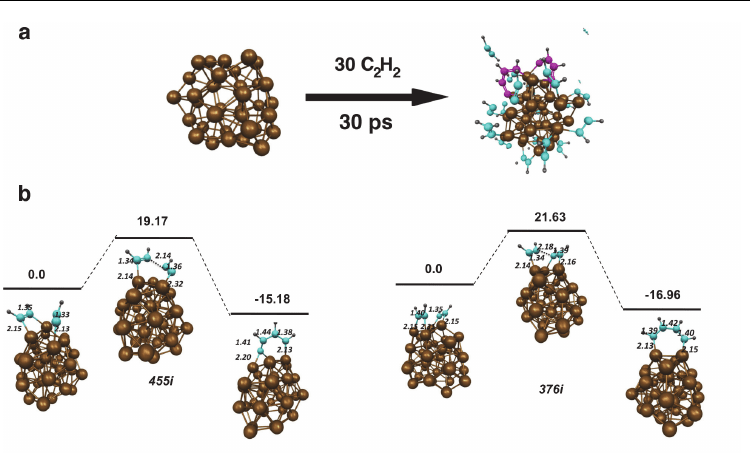
Electronic Properties of Carbon Nanotubes
528
Fig. 1. The initial stages of simulated acetylene CVD on Fe
38
catalyst nanoparticles at 1500 K.
a) Oligomerisation results in the formation of extended polyyne chains on the catalyst
surface within 30 ps. Brown, cyan and grey spheres represent Fe, C and H atoms,
respectively. sp
2
-hybridised C atoms are represented by magenta spheres. b) Examples of C
2
oligomerisation, and their associated energetics. Examples of both the C
2
H
2
+ C
2
H C
4
H
3
and C
2
H
2
+ C
2
H
2
C
4
H
4
oligomerisation reactions are depicted. The C
2
H precursors here
are occasionally produced via the abstraction of atomic H onto the catalyst surface. All
energies and bond lengths given in kcalmol
-1
and Å, respectively. Transition state imaginary
frequencies are given in cm
-1
.
according to the mechanism proposed by Eres (Eres et al., 2009) (see Fig. 2). Structure (iii)
was also observed as a result of the polyyne oligomerisation/cross-linking process. In this
case, the process yielded ‘islands’ of sp
2
-hybridised carbon. Assumedly, QM/MD relaxation
of such structures over longer time scales (i.e. several nanoseconds) would yield a more
consistent network, such as that typical of structure (i). Thus, it is demonstrated here that
SWNT nucleation is not necessarily preceded by a carbon cap-structure, or a liquid carbide
phase. The latter conclusion will be corroborated in §3.2.
3.2 SWNT nucleation on Fe & Ni catalysts via adsorption of gas-phase C
2
It was observed in §3.1 that the removal/sequestration of hydrogen from feedstock
acetylene molecules was the most problematic issue in these QM/MD simulations.
Presumably the same problem would exist regardless of the type of carbonaceous
precursor employed in this respect (be it acetylene, methane, ethanol, etc.). This difficulty
arises due to a problem inherent to MD methods, since such methods have difficulty
overcoming large energy barriers on the global potential energy surface (PES). Although,
in the limit of infinite time, an MD simulation will sample all possible geometrical
configurations, and consequently will have overcome all such barriers on the global PES,
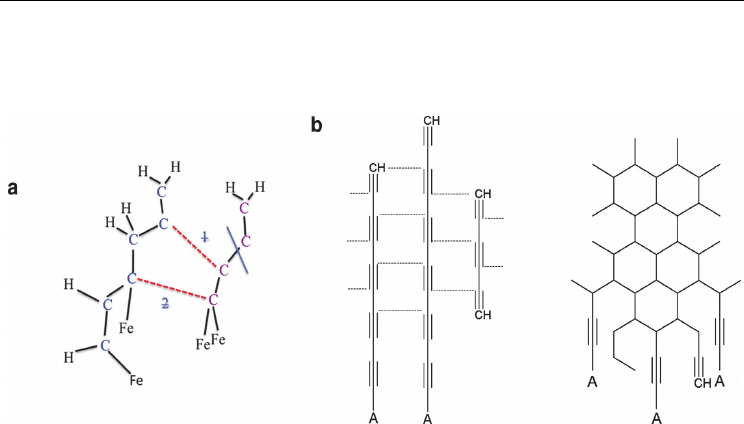
Mechanisms of Single-Walled Carbon Nanotube Nucleation,
Growth and Chirality-Control: Insights from QM/MD Simulations
529
in practice, such sampling is obviously not possible. To this end, we will discuss an
alternative QM/MD approach to the problem of SWNT nucleation on Fe catalysts (Ohta et
al., 2009).
Fig. 2. Oligomerisation, or cross-linking, of extended polyyne chains on the catalyst surface
leads to carbon ring formation. a) Explicit example of cross-linking resulting in pentagonal
ring formation observed in QM/MD simulations. Red lines indicate newly formed C-C
bonds, blue lines indicate broken C-C bonds. Number 1or 2 indicates reaction step. b) Cross-
linking reaction proposed by Eres (Eres et al., 2009), resulting in the formation of a graphene-
type structure. (Reprinted with permission. © 2009 American Chemical Society)
In the present approach, the hydrogen was simply removed from the gas-phase
carbonaceous molecules prior to their interaction with the catalyst nanoparticle. Fig. 4
depicts this adsorption process, and the process of constant temperature annealing that
followed. In this case, the MD relaxation of this Fe
38
-carbon system was continued for 410
ps. Here C
2
moieties have been employed, which are considered to be essentially equivalent
with the gas-phase acetylene feedstock molecules discussed in §3.1. However, the absence of
hydrogen here is not unrealistic, considering the known products resulting from the
vaporisation of graphite/graphene via arc-discharge or laser-ablation processes. In addition,
the use of C
2
allowed the atomistic mechanism of SWNT nucleation to be probed more
easily than before. Fig. 4a shows that this SWNT nucleation process may be partitioned into
three distinct stages. To begin with, C
2
units adsorbed onto the Fe
38
catalyst surface from the
gas-phase. The relatively weak Fe-C interaction energy facilitated the subsequent diffusion
of these C
2
units over the catalyst surface. As a natural consequence of this diffusion, C
2
units ultimately began to interact with each other, coalescing to form longer polyyne chains
(i.e. Fe-C
n
-Fe structures) on/over the catalyst surface. This was apparently the rate-limiting-
step of the nucleation process, in that it was ca. 100 ps before the second stage of the
nucleation mechanism took place (Fig. 4b). This second stage featured the initial ring
condensation processes on the catalyst surface, while the subsequent third stage consisted
entirely of additional ring condensation events, resulting in the formation of a SWNT cap-
fragment. The exact mechanism of this initial ring condensation process is depicted in Fig.
4c. Fig. 4b shows that there was generally a preference for the formation of pentagonal rings,
as opposed to hexagonal or heptagonal rings, during the initial stages of SWNT nucleation.
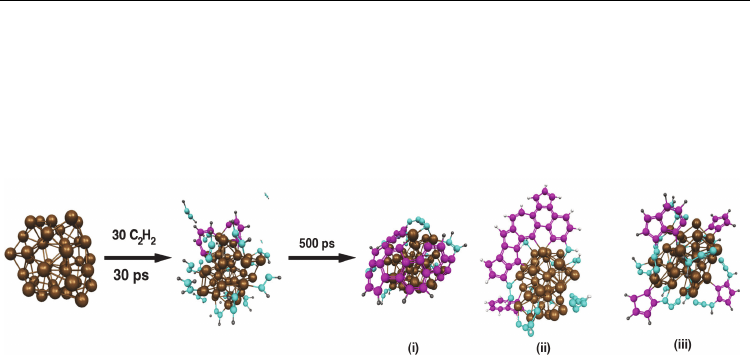
Electronic Properties of Carbon Nanotubes
530
Indeed, the initial ring structure formed was pentagonal. This fact is consistent with
knowledge regarding the formation mechanism of fullerenes at high temperatures (Irle et al.,
2006). The longevity of these pentagonal rings, however, is attributed to the high positive
curvature of the catalyst nanoparticle surface (due to its small diameter) (Fan et al., 2003). In
effect, the growing sp
2
-hybridised carbon network attempts to ‘mould’ itself to its
supporting catalyst substrate from its very beginnings.
Fig. 3. An extended sp
2
-hybridised carbon network is formed on the catalyst surface
following polyyne oligomerisation. QM/MD simulations indicate that structures (i), (ii) and
(iii), are typically formed. Structure (i) is akin to the ‘yarmulke’ SWNT cap fragment
proposed by Smalley et al. (Dai et al., 1996). Structure (ii) is typically formed in the presence
of higher H concentrations, and points to the possibility that SWNT nucleation may take
place in the absence of a SWNT cap fragment. Structure (iii) features a catalyst nanoparticle
covered with sp
2
-hybridised carbon ‘islands’. Color conventions as in Fig. 1; pink spheres
represent sp
2
-hybridised carbon atoms.
The initial pentagonal ring observed in Fig. 4 acted as an anchor, or cornerstone, for all
subsequent ring condensation events. This period of ring condensation (stage three of the
nucleation process) consisted of a periodic process (Fig. 4d) in which adjacent polyyne
chains interacted on the catalyst surface due to their diffusion, thus extending the sp
2
-
hybridised carbon structure. This process is best illustrated by the initial ring condensation
event, in which two adjacent polyyne chains coalesced, resulting in a ‘Y-junction’. This
initial sp
2
-hybridised carbon atom was, in essence, the nucleus of the final SWNT itself, since
all subsequent ring condensation was based around it. The first pentagonal ring formed
following the sinusoidal-type diffusion of the two arms of the Y-junction. With respect to the
original sp
2
-hybridised carbon atom, the most energetically favorable interaction
corresponded to the interaction between the second carbon atoms of each arm. This
therefore explains the observed preference for pentagonal ring formation observed during
the initial stages of SWNT nucleation. It is noted, however, that this interaction was only the
most favorable due to the approximate 120º bond angle provided by the single sp
2
-
hybridised carbon atom. In subsequent ring condensation events, this single carbon atom
was often replaced with a C-C moiety, thus this bond angle was modified (or removed
entirely). The most energetically favorable interaction therefore corresponded to that
between carbon atoms at varying positions along the arms of the Y-junction structures.
As will be discussed in §4, extended polyyne chains play a dominant role not only in SWNT
nucleation, but also in the subsequent ‘continued’ growth of SWNT structures. In this sense,
SWNT growth is therefore very similar to the self-assembly of fullerenes (Irle et al., 2006).
This leads to the conclusion that such polyyne chains are essential for both the conception
and the extension of any sp
2
-hybridised carbon network. Of course, the crucial difference
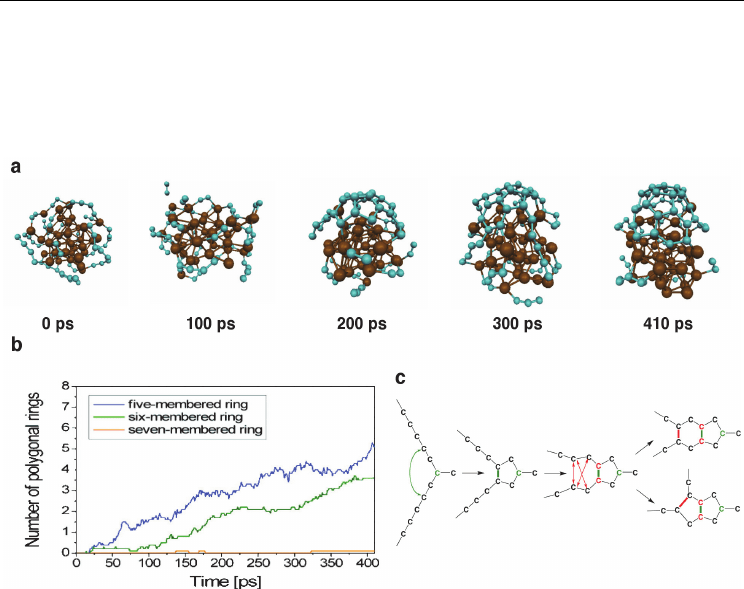
Mechanisms of Single-Walled Carbon Nanotube Nucleation,
Growth and Chirality-Control: Insights from QM/MD Simulations
531
between SWNT and fullerene nucleation here is the presence of the catalyst nanoparticle. In
particular, it is noted here that the QM/MD simulation presented in Fig. 4 once again
verifies the original proposal of Smalley et al., i.e. that one of the fundamental roles of the
catalyst nanoparticle here is preventing the closure of the growing sp
2
-hybridised structure
(Thess et al., 1996).
Fig. 4. SWNT nucleation occurs via three distinct stages, according to QM/MD simulations.
a) QM/MD relaxation of a 30C
2
– Fe
38
model system at 1500 K yields a distinct SWNT cap
fragment after 410 ps. Color conventions as in Fig. 1. b) SWNT nucleation is driven by
successive ring condensation events on the catalyst surface. The preferential formation of
pentagonal rings in this structure is attributed to the curvature of the catalyst surface, and
the diffusion dynamics of extended polyyne chains. c) The SWNT nucleus. A single sp
2
-
hybridised carbon atom acts as the cornerstone of all subsequent ring formation events in
the nascent SWNT structure. (Adapted from (Ohta et al., 2009). Reprinted with permission.
© 2009 American Chemical Society)
3.3 SWNT nucleation from amorphous Fe & Ni carbide precursors
According to the VLS mechanism, CNT nucleation and growth are preceded by a gaseous
carbon/catalyst phase which co-condense forming a catalyst-carbide nanoparticle. Images of
transition metal carbide nanoparticles have been obtained using transmission electron
microscopy on several occasions (Yoshida et al., 2008; Yoshida et al., 2009) (see Fig. 5). Yet, to
date there is no experimental evidence indicating that this carbide phase necessarily precedes
the nucleation and growth of SWNTs. Indeed, QM/MD simulations discussed in §3.1-3.2
indicate that, for nanoparticle catalysts of ca. 1 nm, a carbide phase is not formed at 1500 K.
The thermodynamic stability of bulk transition metal carbide nanoparticles have also been
drawn into question from a number of independent approaches. Assumedly then, SWNT
nucleation may occur in the absence of a carbide phase. Such disparities between theoretical

Electronic Properties of Carbon Nanotubes
532
and experimental assertions give reason for further study of the role of the carbide phase
with respect to SWNT nucleation and growth.
QM/MD simulations of SWNT nucleation from amorphous Fe- and Ni-carbide
nanoparticles at 1400 K are depicted in Fig. 6. It is evident from this figure that, upon MD
relaxation at constant temperature, the amorphous carbide phase almost immediately
decomposes (within ca 5 – 10 ps), yielding segregated Fe/Ni-carbon systems. This
phenomenon is known to take place regardless of temperature, or the carbon concentration
in the amorphous carbide phase (Page et al., 2010d). Fig. 6 also indicates that the SWNT
nucleation mechanism in this case (from a Ni-carbide) is the same as that presented in §3.1-
3.2. For example, the almost immediate precipitation of carbon from the nanoparticle bulk to
the surface leads to the formation of extended polyyne chains over the nanoparticle surface.
The oligomerisation/cross-linking etc. of these chains then leads to the formation of
primarily pentagonal and hexagonal rings (Fig. 6a) as the SWNT cap fragment is formed.
The initial ring structure in all cases here is invariably a pentagonal ring. Thus, the SWNT
nucleation mechanism on Fe/Ni catalysts is evidently independent of the type of metal
catalyst, temperature, and origin/type of the feedstock carbon employed. While the fact that
SWNT nucleation originates from a Ni-carbide structure is not unexpected (since it has been
predicted in several prior REBO-based MD investigations (Shibuta & Maruyama, 2002;
2003)), what is remarkable is the invariance of the SWNT nucleation mechanism with
respect to these pertinent experimental factors.
Despite this invariance, differences in the ultimate product of this nucleation process are
evident with respect to both the catalyst type and the simulation temperature. The kinetics
of SWNT nucleation was also affected by the type of catalyst employed – explicitly, SWNT
nucleation from the decomposition of Ni-carbide proceeded more quickly, compared to that
from Fe-carbide (see Fig. 6 and Fig. 7). It was observed that at higher temperatures (2000 K,
as opposed to 800 or 1400 K), the populations of pentagonal and hexagonal rings in the
SWNT cap fragment were approximately equal. On the other hand, at lower temperatures a
distinct preference towards pentagonal ring formation existed. These differing ring
populations were ascribed to the effect of temperature on the SWNT nucleation dynamics.
At higher temperatures, the growing polyyne chains on the catalyst surface are more
thermally excited, and thus exhibited larger amplitude vibrational motion. Considering the
pentagonal ring mechanism given in Fig. 4c, this increased motion makes the formation of a
C-C bond between tertiary carbon atoms (with respect to the sp
2
-hybridised ‘cornerstone’
carbon atom) more likely. Hence, hexagonal ring formation is more probable in this case.
Perhaps the most important difference observed between the kinetics of SWNT nucleation
from Fe- and Ni-carbide nanoparticles, however, pertains to the relative rates of SWNT
nucleation. It was recently established that SWNT nucleation is significantly more labile on
Ni catalysts, compared to Fe catalysts. This observation may be directly attributed to the
relative strengths of the catalyst-carbon interactions. This point will be a recurring theme
throughout the present work, as it dominates many aspects of both SWNT nucleation and
growth. For example, the catalyst-carbon interaction strengths, calculated using SCC-DFTB,
are 1.78 and 1.06 eV for Fe-C and Ni-C, respectively. For comparison, the C-C interaction
strength is 9.14 eV. Therefore, Fe-C bond formation is more favorable than Ni-C bond
formation, in a thermodynamic sense. Consequently, C-C bond formation during the
decomposition of Fe-carbide nanoparticles is impeded, which in turn impedes the nucleation
of the sp
2
-hybridised carbon network. This argument also explains other phenomena related to
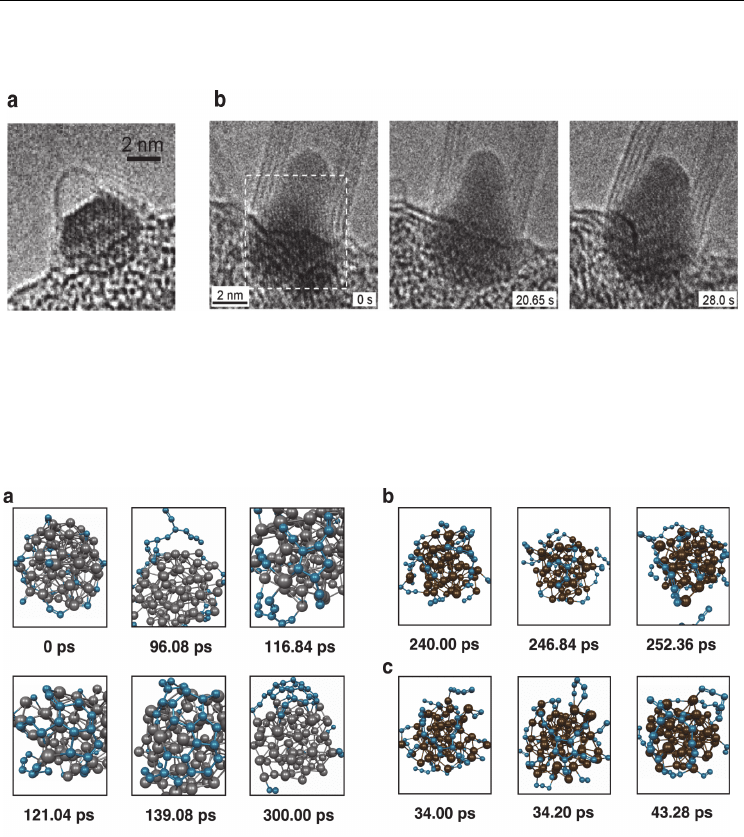
Mechanisms of Single-Walled Carbon Nanotube Nucleation,
Growth and Chirality-Control: Insights from QM/MD Simulations
533
SWNT nucleation, such as the lifetimes of the bulk and subsurface carbide intermediate
species (Page et al., 2010d) (see Fig. 7). In particular, the average time required for
Fig. 5. TEM images of intermediate structures observed during SWNT growth experiments.
a) A SWNT cap-fragment bound to a crystalline Fe
3
C nanoparticle with an approximate
diameter of 2 nm. (Adapted from (Yoshida et al., 2008). Reprinted with permission. © 2008
American Chemical Society) b) A MWNT growing from a (Fe,Mo)
23
C
6
nanoparticle catalyst.
In this case the nanoparticle diameter is ca. 6 nm. (Adapted from (Yoshida et al., 2009).
Reprinted with permission. © 2009 American Chemical Society)
Fig. 6. The kinetics of SWNT nucleation from Ni-carbide are enhanced relative to those from
Fe-carbide. Nevertheless, the mechanism of SWNT nucleation is identical in both cases. a)
The evolution of a computed SWNT nucleation trajectory from a Ni
77
C
39
carbide
nanoparticle at 1400 K. The SWNT cap fragment is formed within 300 ps following repeated
ring condensation events. b), c) The evolution of two Fe
58
C
58
carbide nanoparticles at 1400 K.
The stronger Fe-C interaction impedes the formation of C-C bond, and therefore impedes
the SWNT nucleation process itself. Both trajectories show examples of the formation, and
subsequent destruction, of pentagonal carbon rings. Color conventions as in Fig. 1; grey
spheres represent Ni atoms. (Adapted from (Page et al., 2010d). Reprinted with permission.
© 2010 American Chemical Society)
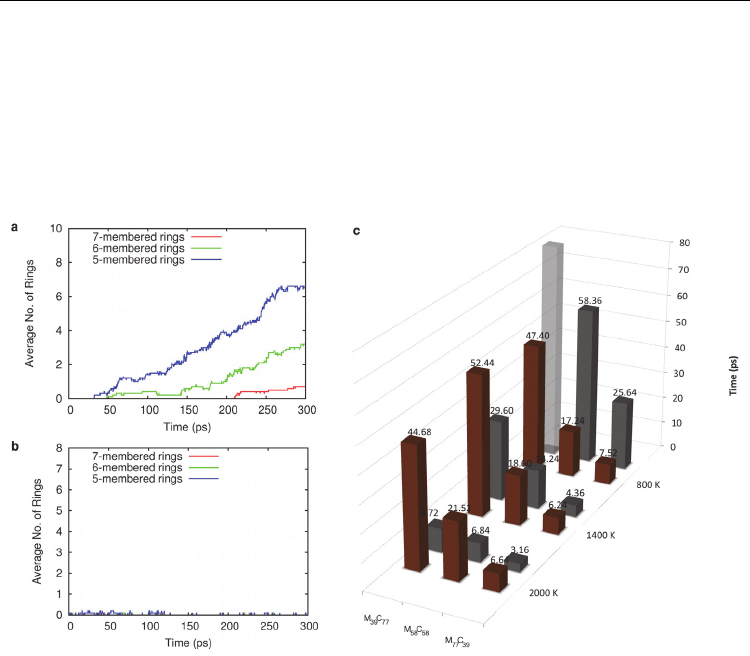
Electronic Properties of Carbon Nanotubes
534
precipitation of all carbon from the nanoparticle bulk to the nanoparticle
surface/subsurface in the case of Fe-carbide always exceeds that for Ni-carbide, except at
low temperatures. At 800 K, the reverse is the case, since the Ni-carbide nanoparticle
exists in the solid phase, while the Fe-carbide nanoparticle is liquid. These QM/MD
findings therefore support recent claims that a subsurface carbide structure (in which a
high density of carbon exists at, or just below, the nanoparticle surface) precedes SWNT
nucleation and growth (Amara et al., 2006; 2008b; a; Harutyunyan et al., 2008; Amara et al.,
2009).
Fig. 7. The kinetics of SWNT nucleation from Ni-carbide are enhanced relative to those from
Fe-carbide. Average polygonal carbon rings formed from a) Ni
58
C
58
and b) Fe
58
C
58
at 1400 K.
c) Average carbon precipitation times (in ps) for Fe- and Ni-carbide nanoparticles between
800 and 2000 K. Fe-carbide carbon remains within the nanoparticle bulk for a longer time
period, compared to Ni-carbide carbon, due to the stronger Fe-C interaction. At 800 K the
trend is reversed since Ni-carbide exists in the solid phase. All data averaged over 10
trajectories. Brown and grey columns refer to Fe- and Ni-carbide data, respectively.
Transparent columns indicate precipitation times greater than 300 ps. (Adapted from (Page
et al., 2010d). Reprinted with permission. © 2010 American Chemical Society)
3.4 A new breed of catalysts: SWNT nucleation on SiO
2
, SiC and Si
The mechanism of SWNT nucleation on traditional, transition metal catalysts such as Fe, Ni
and Co has now been the subject of both experimental and theoretical scrutiny for
approximately a decade. Since 2009, however, a number of experimental reports (Takagi et
al., 2007; Liu et al., 2008; Bachmatiuk et al., 2009; Homma et al., 2009; Huang et al., 2009; Liu et
al., 2009a; Liu et al., 2009b; Liu et al., 2010a; Liu et al., 2010b) have established non-traditional
nanomaterials to be catalytically active in the context of SWNT nucleation and growth from
methane and ethanol CVD. Si-based materials, and in particular SiO
2
, have been remarkably
